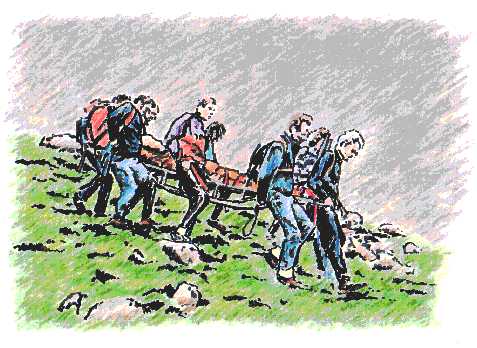
It was only a simple scramble.....
The following is a true story about a walker who desperately needed the help of the Wasdale Team in November 1998. It accurately describes the event of that day and was written by Mike Greene, our Team Doctor on the rescue.
Richard Warren - Secretary WMRT, 12 April 2000
A successful mountain rescue is the
result of many people working
together. On
15 July 1998 a fell walker from Manchester found himself the reluctant center
of attention in one of Wasdale’s
more difficult rescues.
A scramble along Lord’s Rake path on
Scafell had ended in near disaster when he fell down Red Ghyll and stopped on
the edge of a steep waterfall. The
following story is a chronological account of events as they unfolded on that
day. The record illustrates the
wide variety of people involved in a mountain rescue.
·
Andrew falls on Lord’s Rake path into
a gully sustaining serious head and
limb injuries.
·
The alarm is raised by mobile telephone
from the hillside. This saves much
valuable time. Other mountaineers
give basic first aid.
·
The police control room pass the
details of the accident to the Wasdale Mountain Rescue Team Leader who
immediately calls the team by the pager system and requests RAF helicopter back
up.
·
A Wasdale Mountain Rescue team member
who is out fell running reaches the casualty site to assist those present.
·
Team members ( 22 in all with 1 base
operator) attend for the rescue.
·
The advanced party reach Wasdale Head.
·
An RAF helicopter from RAF Boulmer
reaches Scafell but due to bad weather cannot reach the location of the casualty
. It returns to the valley and
collects the advanced party including Team Leader and doctors from valley.
The helicopter cannot land and they jump out of the aircraft
( was it really only 10 feet !).
·
Bystanders have helpfully marked the
way through the mist to the accident location which it is now clear is in a
steep and inhospitable gully.
·
The backup party are informed of the difficult location and the need to
prepare equipment for a complex crag rescue.
The helicopter continues to ferry vital equipment and personnel as near
the crag as possible despite ever deteriorating viability.
· A wet and rough scramble leads to the site at the top of a waterfall where the seriously injured walker is lying semiconscious in a stream bed in a precarious situation.
·
Team members and doctors assess and
start to treat the casualty's injuries.
·
Other vulnerable party members are led
to a place of greater safety. A
crag party working on difficult ground and with poor quality rock work as
quickly as possible to establish multiple belays (anchors in the rock face) to
protect those working below and for the stretcher lower which must follow.
·
More team members arrive with 200 m
ropes and the stretcher. These are
heavy loads to have on your back as you climb the near vertical bog of Scafell
Shamrock.
·
The serious nature of the casualty's
injuries is apparent . A serious
head injury with a rapidly deteriorating condition, a dislocated elbow, a
chest injury and fracture of the knee.
·
It is raining and visibility has closed
in to a hundred meters.
Time is critical and the casualty must reach hospital as soon as possible
but safety on the mountain is essential.
·
The stretcher is lowered to the foot of
the crag and carried through the mist to the waiting helicopter.
 |
·
There are almost no land marks for the
pilot. One man hangs out of the
door watching the ground as the helicopter inches its way down the side of the
mountain. We have to stop and hover
again a few feet from the ground because all visibility is lost.
Suddenly we are out of the cloud, the Lake is in site and we turn and
head for West Cumberland Hospital.
·
By pre-arrangement via the team’s
base operator the Trauma Team of experienced doctors and nurses is assembled in
the resuscitation room to assess and continue
the casualty's medical care.
He is immediately placed on a life support machine and an emergency brain
scan shows a life threatening blood clot.
·
Meanwhile back on the hillside team
members remove the ropes and equipment from the crag, help other party members
to the safety of the valley and walk down the mountain in the rain.
·
Following consultation with the
Newcastle Neurosugical Unit an emergency operation is undertaken in Whitehaven
to relive the pressure on the brain. This
vital surgery is rarely undertaken
in a District General Hospitals but in some circumstances it is required to save
life.
·
Meanwhile the casualty's family and
friends wait anxiously aware of the gravity of the situation while hospital
staff attempt to provide some support.
·
Rescue team members clean equipment and
prepare the rescue base for the next call out.
They return home to long suffering family, friends and employers who
“tolerate” their disappearance to call outs.
·
The casualty is transferred by road Ambulance to
Newcastle General Hospital. He
requires further surgery and
treatment in Intensive Care followed
by rehabilitation.
· Andrew makes a full recovery and returns to work in November 1998.
·
Our
casualty has now returned to his previous
employment and is gradually recovering from his ordeal on the northern slopes of
Scafell.
It’s because many people and organisations were able to work together with
co-operation that this story has a happy
ending.
By Mike Greene, Team Doctor, with the kind permission of the injured walker.